U.S. Department of Transportation
Federal Highway Administration
1200 New Jersey Avenue, SE
Washington, DC 20590
202-366-4000
Federal Highway Administration Research and Technology
Coordinating, Developing, and Delivering Highway Transportation Innovations
|
Research & Technology Transporter This newsletter is an archived publication and may contain dated technical, contact, and link information. |
|
| Publication Number: N/A Date: November 2003 |
Publication Date: November 2003
|
Water flow washing away sediment at the base of bridges can cause scour, leaving a hole. If the scour is severe, the bridge foundation can become unstable and threaten vehicle safety. Bridges under these conditions are classified as scour-critical. To improve safety and reduce scour, State and local transportation agencies need to evaluate the structures before they become scour-critical and put plans in place to repair or replace them when scour presents a hazardous situation.
Since 1988, members of the Federal Highway Administration’s (FHWA) Office of Bridge Technology have helped State departments of transportation (DOTs) improve the safety of their bridges. Through the National Bridge Scour Evaluation Program, FHWA assists State DOTs in examining bridges for scour and developing plans of action (POAs) for scour-critical bridges. As a result, FHWA now encourages State DOTs to evaluate at least 90 percent of all the bridges in the region that require evaluation. FHWA has not established a specific timeframe within which States must reach this goal.
To assist Ohio, for example, in reaching the 90 percent goal, FHWA recently held a meeting with engineers from Ohio DOT and several county transportation agencies, and spoke at the Ohio Bridge Conference. FHWA focused much of the discussion on POAs developed and implemented in Oregon and Florida that could serve as examples to other States. The Oregon POA is a step-by-step flow chart detailing the required level of maintenance on bridges over the Snake River affected by scour. In addition, the Oregon POA identifies countermeasures to prevent scour, such as annual underwater inspections. The Florida DOT uses a POA for a bridge over the St. John’s River. Like the Oregon POA, the Florida plan discusses countermeasures, such as a permanent monitoring program, plus implementation costs and actions to take if the bridge were closed temporarily.
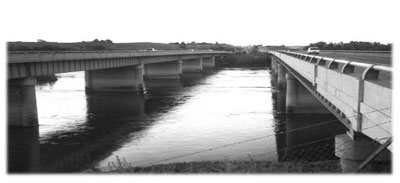 |
| Bridges over the Snake River near Ontario, OR. |
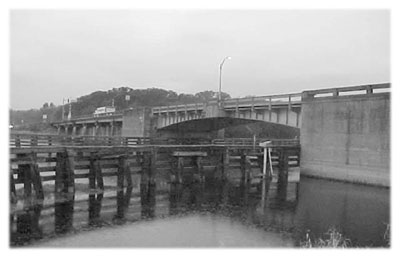 |
| A bridge over St. John’s River in Florida. |
To illustrate the information included in a POA, FHWA showed conference attendees a generic POA that they could customize to meet their own needs. The POA template provides space for filling in extensive information about each bridge, including its construction history, the methods that State and local transportation agencies use to conduct scour evaluations, the criteria for bridge closures and re-openings, recommended countermeasures and costs, and detour routes.
For additional guidance in writing a POA, FHWA referred conference attendees to FHWA’s Hydraulic Engineering Circular No. 23 (HEC-23), titled “Bridge Scour and Stream Instability Countermeasures,” and Hydraulic Engineering Circular No. 18 (HEC-18), titled “Evaluating Scour at Bridges.” Both publications are available on the Internet at https://www.fhwa.dot.gov/engineering/hydraulics/library_arc.cfm?pub_number=17&id=37.
Since the inception of the National Bridge Scour Evaluation Program in 1988, FHWA has helped State DOTs evaluate 93 percent of the more than 480,000 bridges identified as crossing over waterways. Based on these evaluations, FHWA found that more than 6,000 of these bridges are scour-critical. In addition to assistance with evaluations, FHWA helps State DOTs with decisions about monitoring, repairing, and, in some cases, replacing bridges identified as scour-critical.
Jorge Pagán 202–366–4604 jorge.pagan@fhwa.dot.gov
Within the transportation industry, the worlds of education, research, and practical implementation all have their champions. In recognition of his remarkable contributions to transportation education, Dr. Adolf R. May recently received the 2003 S.S. Steinberg Award from the American Road and Transportation Builders Association (ARTBA). Created in honor of the founding president of ARTBA’s Research and Education Division, the award is for individuals who have made exceptional contributions to transportation education.
"This award not only recognizes the valuable contributions that Dr. May has made to transportation, but also highlights the importance ARTBA places on excellence in education and the value of preparing our next generation of transportation professionals," said Associate Administrator Joe Toole, head of the Federal Highway Administration’s (FHWA) Office of Professional Development.
Today, May is a professor emeritus at the University of California-Berkeley. He has published more than 300 papers and reports, plus Traffic Flow Fundamentals, a textbook used in a graduate course in traffic flow. In addition, May led the development of the "FREQ" macroscopic model for simulation of freeway corridors. The FREQ model is widely used in the design of traffic control devices.
For FHWA and the California Department of Transportation, May helped design educational programs in intelligent transportation systems. He also contributed to the 2000 edition of the Highway Capacity Manual. In addition, May is a recognized leader for his work on the design and operation of highways, rural roads, urban streets, and intersections. May’s contribution to development of the first ramp-metering device in 1963 is just one of many achievements in his career of technical innovation.
Through the years, May’s technical expertise and research led him to several prominent positions in the transportation industry. In 1962, he became the director of the Illinois Department of Transportation’s Chicago Area Expressway Surveillance and Control System—believed to be the world’s first computerized traffic management system for freeways. May later became the assistant secretary of the Institute of Transportation Engineers (ITE). He served on the Transportation Research Board’s (TRB) Technical Council and Executive Committee, and served as the chair of TRB’s freeway operations, traffic signal systems, and highway capacity committees.
In addition to the S.S. Steinberg Award, May has received other honors from the transportation community. In 1990, he became one of fewer than 20 transportation engineers ever elected into the National Academy of Engineering, in special recognition of his work with traffic engineering and traffic flow. He also received the California Department of Transportation Award for Excellence in Research (1987), ITE’s Theodore M. Matson Memorial Award (1992) and Wilbur S. Smith Distinguished Transportation Educator Award (1998), TRB’s Thomas B. Deen Distinguished Lectureship (1994), and the Roy Crum Distinguished Service Award (1996).
Nancy Stout 703–235–1260 nancy.stout@fhwa.dot.gov
Roadside erosion and the resulting sediment can be a problem on rural roads, damaging vegetation and infiltrating nearby waterways. Erosion also can create the need for costly maintenance and repairs by the rural transportation agencies that build and maintain nearly 4.8 million kilometers (3 million miles) of roadways and 29,000 bridges across the United States.
Recently, the Minnesota Local Technical Assistance Program (LTAP), with funding from the Federal Highway Administration (FHWA), Minnesota Department of Transportation, and Minnesota Local Road Research Board, developed the Erosion Control Handbook for Local Roads. The handbook serves as a resource for local transportation agencies by providing guidelines and methods for effective control of erosion on low-volume roads. It illustrates the methods with case studies, outlines best management practices, and offers guidance on cooperating with local watershed districts and other agencies.
One of the case studies describes the reconstruction of an 11.3-kilometer (7-mile) stretch of roadway located near wetlands and on sandy soils in Crow Wing County, MN. To address the potential for erosion during construction and afterwards, the project managers and engineers implemented a number of methods. Their strategies included placing bales of hay in ditches near the roadway to reduce flow velocity and trap sediments, and constructing a heavy-duty fence made of silt to reduce the amount of sediment leaving the construction site.
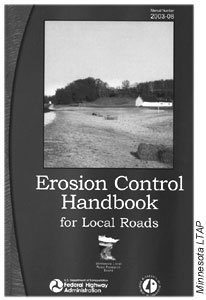 |
| The Erosion Control Handbook for Local Roads (cover pictured here) will assist counties, townships, and local units of government by providing guidelines and methods for implementing plans to control erosion on low-volume roads. |
Among the other topics in the handbook are designing a plan for controlling erosion, selecting treatments for erosion problems, understanding regulations and the permitting process, and controlling both general erosion along roadways and erosion produced during specific road construction projects.
The construction process, since it typically involves soil disturbance, greatly increases the possibility of erosion problems. To reduce or control erosion during construction, the handbook offers a list of best practices. Effective methods include minimizing the size of the area exposed to construction at a given time, reducing the length of time the area is uncovered, stripping and storing existing topsoil for later replacement, and developing a plan for temporary seeding as areas of construction are completed. The handbook also recommends using some erosion control practices throughout construction, such as keeping disturbed soil covered and contouring slopes to prevent them from washing away.
The Erosion Control Handbook for Local Roads (manual number 2003-08) is available on the Minnesota LTAP Web site at www.mnltap.umn.edu/pdf/erosioncontrolhandbook.pdf.
In 1982, the Federal Highway Administration (FHWA) created LTAP to help improve the skills and knowledge of local transportation providers through training, technical assistance, and technology transfer in the Nation’s 38,000 local communities. LTAP is composed of a network of centers in every State and Puerto Rico, plus regional centers serving tribal governments.
Jon Schans 703–235–0509 jon.schans@fhwa.dot.gov
To move forward in their careers, transportation engineers and other professionals frequently are required to satisfy continuing education requirements and keep up with professional training. This requirement often means taking courses taught by International Association of Continuing Education and Training (IACET) providers in order to earn nationally recognized Continuing Education Units (CEUs). As of January 1, 2004, the Federal Highway Administration’s National Highway Institute (NHI) will award IACET CEUs to participants who successfully complete NHI courses.
IACET is an independent, nonprofit association whose goal is to ensure quality continuing education for professionals. To become a unit provider for continuing education, organizations like NHI must demonstrate the capacity to design and develop training in accordance with proven adult education theory and recognized practices in instructional systems design.
According to NHI Director Moges Ayele, those who evaluate lifelong learning experiences for professional development recognize the value of training delivered by IACET-approved organizations. “Our customers expect high-quality, outcome-oriented training,” Ayele says. “Being an IACET-authorized provider assures them that we develop and deliver training that meets recognized standards of excellence.”
Several factors influenced NHI’s decision to become an authorized training provider. NHI has a reputation for developing quality training, but also wanted acknowledgment from the recognized standard bearer in the field. In addition, a trend is growing among States to require annual continuing education for professional employees. Currently, 26 States require professional engineers to participate in annual or biennial professional education. Recognition by IACET assures employees and employers that taking an NHI course will be a valuable use of time and scarce training dollars.
To learn more about transportation-related training courses available from NHI, consult the course catalog at www.nhi.fhwa.dot.gov or contact NHI at 4600 N. Fairfax Drive, Suite 800, Arlington, VA, 22203; 703–235– 0500 (phone); or 703–235–0593 (fax).
Nancy Stout 703–235–1260 nancy.stout@fhwa.dot.gov
When natural or catastrophic disasters strike, they can cause damage to highways and affect transportation services. Disasters can prevent at-risk motorists from using transportation systems to flee from danger and can disrupt access by emergency response and recovery units. Therefore, Federal and State agencies must have the resources to fund repairs and restore transportation services and mobility as quickly as possible.
In August 2003, the Federal Highway Administration (FHWA) posted an updated version of the Emergency Relief Manual on the Internet at www.fhwa.dot.gov/reports/erm/. The updated manual, which provides guidance to States in applying for emergency relief funds, replaces an earlier version published in 1998.
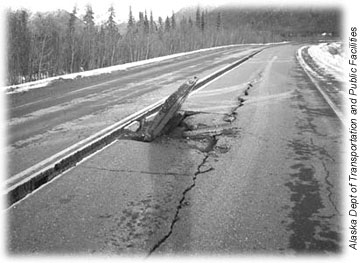 |
| This piece of asphalt buckled on a cracked section of the Tok Cutoff Highway, a major road in Alaska, during an earthquake on November 3, 2002. Damage such as this can limit mobility and may require that State agencies apply for emergency relief funds. |
The manual is part of FHWA’s emergency relief program, which helps State agencies cover the expenses of repairs to Federal-aid highways that have suffered severe damage due to natural disasters, such as hurricanes or earthquakes, or catastrophic failures from external causes, such as a bridge collapsing after being hit by a barge. The resources from FHWA’s program help supplement funds that States or other Federal agencies provide to help pay for unusually heavy expenses resulting from extraordinary disaster conditions.
Much of the new information included in the updated manual relates to regulatory changes made to the emergency relief program in recent years. The most significant regulatory change is the new authority for FHWA division offices to approve requests for disaster funding. In the past, funding applications from State transportation agencies went to FHWA’s headquarters for approval. According to the regulatory change, FHWA division administrators now can evaluate damage reports and determine whether to approve the payment of emergency funds. Enabling FHWA division administrators to approve emergency funding makes the process of applying for and obtaining funds faster and easier for State agencies.
In another regulatory change, FHWA raised the eligibility threshold for emergency funds to reflect the rising costs of highway maintenance and repair. States now must sustain at least $700,000 per disaster in damage to Federal-aid highways to qualify for funds, as opposed to $500,000 in the past. FHWA can provide up to $100 million in emergency relief funding to a State for damages caused by each natural disaster or catastrophic failure that is determined to be eligible under the program.
The updated manual also provides information on policies and procedures for requesting, obtaining, and administering emergency relief funds. The manual includes instructions for damage assessments, site inspections, and eligibility determinations. In order for an agency to apply for funding, damage to highways must be severe, occur over a wide area, and result in unusually high expenses to the transportation agency. To qualify, a catastrophic failure must involve the sudden, complete failure of a major element or segment of a highway system, resulting in a disastrous effect on transportation services. The cause of the failure must be external to the highway facility rather than being an inherent flaw.
After reauthorization of the Transportation Equity Act for the 21st Century, FHWA may publish a more comprehensive update of the Emergency Relief Manual, especially if the legislation calls for further regulatory modifications governing the relief program.
Greg Wolf 202–366–4655 greg.wolf@fhwa.dot.gov
According to a 2002 survey by the National Highway Traffic Safety Administration (NHTSA), 37 percent of drivers admit that they have nodded off for at least a moment or fallen asleep while driving at some time in their lives. NHTSA conservatively estimates that 56,000 police-reported crashes are the direct result of driver fatigue each year, resulting in an estimated 40,000 injuries. Because of the inherent danger posed by drowsy drivers, some States are intensifying their efforts to reduce driver fatigue. New Jersey, for example, recently passed a new law that makes driving while tired a crime in fatal crashes. The law allows prosecutors to charge a sleep-deprived driver with vehicular homicide—a crime punishable by up to 10 years in prison and a $100,000 fine.
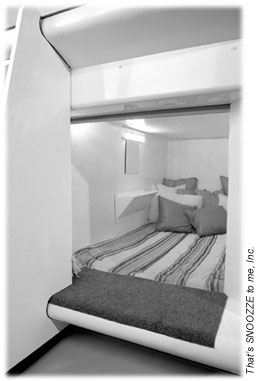 |
| The ZAP NAP POD sleeping compartment is similar in measurement to a twin bed and includes a pillow and foam mattress. The compartments can hold up to 380 kilograms (840 pounds) comfortably and are surrounded by walls with a 0.915-meter (3-foot) sliding blind. |
While some States are looking for ways to punish drowsy drivers, others are looking for ways to encourage drivers to rest when they become tired. Recently, the Federal Highway Administration’s (FHWA) Central Federal Lands Highway Division in Lakewood, CO, held a presentation on portable sleeping centers for engineers at FHWA and the Colorado Department of Transportation. The centers, known as a SNOOZZE Centers, are easy-to-assemble and provide weary drivers with a comfortable, private, clean, and safe place to sleep at rest stops.
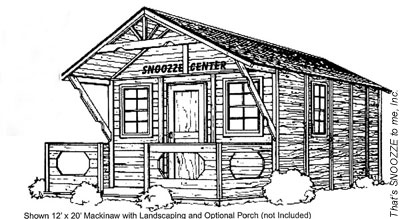 |
| The Mackinaw (above), designed specifically for public rest areas, includes four sleeping compartments and four lounge chairs. |
The centers typically consist of modular sleeping compartments, known ZAP NAP PODs, and lounge chairs. Insulated walls reduce light and sound in each sleeping compartment. A 24-hour attendant staffs the centers and keeps the facilities clean and secure. Drivers may nap for up to 3 hours in the sleeping compartments for a cost of $0 to $5 per hour, to be determined by the State or private company that provides the service.
During the presentation, the creators explained how the napping centers work, and how they can reduce crashes by enabling weary drivers to rest before getting back on the road. The creators estimate that the centers could eliminate at least 5 percent of fatigue-related fatalities each year if implemented nationwide. They also discussed details about the safety and costs of installing the centers. Each unit costs $136,000, and regular maintenance and staffing run approximately $15,500 per month.
“These costs are offset by the savings resulting from avoided fatalities and economic losses, estimated at $250 million per State per year,” says Karen Renz, director of That’s SNOOZZE to me, Inc., the company marketing the centers.
In addition, several law enforcement agencies have endorsed the use of sleep centers at rest areas. At a test site in Pueblo, CO, for example, the local, county, and State law enforcement agencies all supported installing centers. “As the program expands across the United States,” adds Renz, “we expect similar cooperation from other States.”
Federal agencies and private businesses also are considering installing centers at rest areas and large parking lots. Within 2 years, Renz estimates that 1,200 pod facilities will be installed nationwide.
Roger Surdahl 303–716–2158 ext. 3158 roger.surdahl@fhwa.dot.gov
To save time and money and to avoid duplication of efforts, transportation professionals need timely access to information and convenient ways to exchange ideas on specific topics. Even the most current technologies, however, do not allow performance of these tasks from a central location. Most Web sites contain useful information, for example, but typically do not enable users to interact. List-servs and electronic discussion boards permit interaction via individual e-mail postings between users, but busy transportation professionals may lose or overlook the messages among the many other e-mails that they receive. Due to scheduling conflicts and limited resources for travel, even teleconferences and face-to-face meetings are not always effective ways to exchange information.
To solve these problems, the Federal Highway Administration (FHWA) developed online Communities of Practice (CoPs). Through these Web-enabled networks, transportation professionals can interact with their peers, provide or receive data and other information, and share success stories and lessons learned. In 1998, FHWA developed its first CoP, focused on rumble strips, as part of its Knowledge Sharing Initiative. The agency has now developed 10 CoPs on various topics. Users can access and search all of these communities though a single point of entry on the Internet at http://knowledge.fhwa.dot.gov.
The 10 CoPs offer a place where professionals can participate in interactive online discussions and document sharing. Users can sign up for daily e-mail notifications about topic areas of interest and access research and presentation materials and publications. The sites are targeted for use by public agencies, private sector consultants, transportation researchers, and the public.
The “Re: NEPA” CoP includes information about the National Environmental Policy Act of 1969 (NEPA) and related environmental issues, providing a place where professionals can ask questions about environmental compliance, project development, and transportation decisionmaking. For example, a consultant from Colorado visited the site looking for information on the impacts of noise on wildlife. By participating, the user found the information when an employee from FHWA’s Office of Planning, Environment, and Realty offered to send a literature synthesis on the topic.
Recently, FHWA conducted an evaluation survey of the “Re: NEPA” CoP. “The ‘Re: NEPA’ site is very valuable as a resource and [for] staying in touch with issues and the professional community,” said one user. Another user commented, “My job is now easier knowing that I can get expert information on a number of subjects quickly.”
Another CoP, the “High Performance Concrete Exchange” (HPC), addresses several topics related to a specialized series of concrete. HPC provides benefits over traditional mixes, such as bridge and roadway construction that is less materials-intensive and may allow use of fewer beams. Topics on this CoP include structural design and specifications, mix design, and cost.
Recently, the administrator for the HPC CoP asked State departments of transportation and local agencies to update FHWA on whether they have experienced cracking in bridge decks made from HPC; what they had done to repair the cracks; and what changes to structural design, mix design, or construction specifications were made as a result. CoP users responded from Florida, Kentucky, Massachusetts, Minnesota, New Hampshire, and Texas.
CoPs not only provide transportation professionals with technical information on topics such as concrete specifications, but these sites also can help them locate nontechnical resources. For example, a user from Missouri on the “It All Adds Up to Cleaner Air Exchange” CoP used an online discussion group to find posters relating to air quality. The requestor soon received responses and suggestions from all over the country.
The “It All Adds Up to Cleaner Air Exchange” is a joint effort between the U.S. Department of Transportation and the U.S. Environmental Protection Agency (EPA) to assist regional, State, and community agencies with their efforts to reduce traffic congestion and air pollution. Users of this CoP include staff from FHWA, EPA, the Federal Transit Administration, and numerous State and local partners.
Due to the effectiveness and popularity of the CoPs, FHWA has been recognized as an early adopter and leader in knowledge management. The agency has received several awards for the CoPs, including the E-Gov 2001 Explorer Award, Government Executive’s 2001 Government Technology Leadership Award, and the E-Gov 2003 Knowledge Management Award. Most recently, the team at FHWA responsible for developing the CoPs received the FHWA Administrator’s Strive for Excellence Customer Service Award.
Mike Burk 202–366–8035 mike.burk@fhwa.dot.gov
The ability of State and Federal agencies to manage the Nation’s transportation resources is affected strongly by the quality of the data and information that the agencies collect using traffic-monitoring devices. Obtaining high-quality traffic data is often a challenge due to "data gaps" and coverage deficiencies; data collection and communications equipment malfunctions; data elements that do not match location and time elements; and conflicts in the way that different agencies format data.
To help address these issues and provide guidelines for data collection, the Federal Highway Administration’s (FHWA) Office of Policy recently released the Traffic Data Quality Workshop Proceedings and Action Plan. The objective of the report is to outline steps that the U.S. Department of Transportation, Federal and State transportation agencies, stakeholder organizations such as the American Association of State Highway and Transportation Officials and ITS America, and private industry can take to determine and improve the quality of traffic data that they are providing, sharing, and using.
The development of the plan involved several steps. First, FHWA reviewed the issues and developed three white papers on traffic data quality and collection. The information in the papers is based on published reports and interviews with State and local agencies that collect, use, and manage traffic data. Next, FHWA conducted two regional workshops in March 2003 to gather input on the white papers and to stimulate discussions on data collection. Finally, FHWA developed the action plan based on the findings from the white papers and the regional workshops.
According to the plan, agencies and organizations responsible for collecting traffic information should take the following actions to help improve data quality:
In addition to detailed descriptions of each action, the report contains the text of the white papers and the proceedings from the regional workshops. To download a copy of the report, visit www.itsdocs.fhwa.dot.gov//JPODOCS/REPTS_TE//13839.html.
 |
| FHWA’s Traffic Data Quality Workshop Proceedings and Action Plan provides transportation agencies with steps they can take to improve the quality of data collected about traffic, such as congestion shown above. |
For more information, contact:
Ralph Gillmann 202–366–5042 ralph.gillmann@fhwa.dot.gov